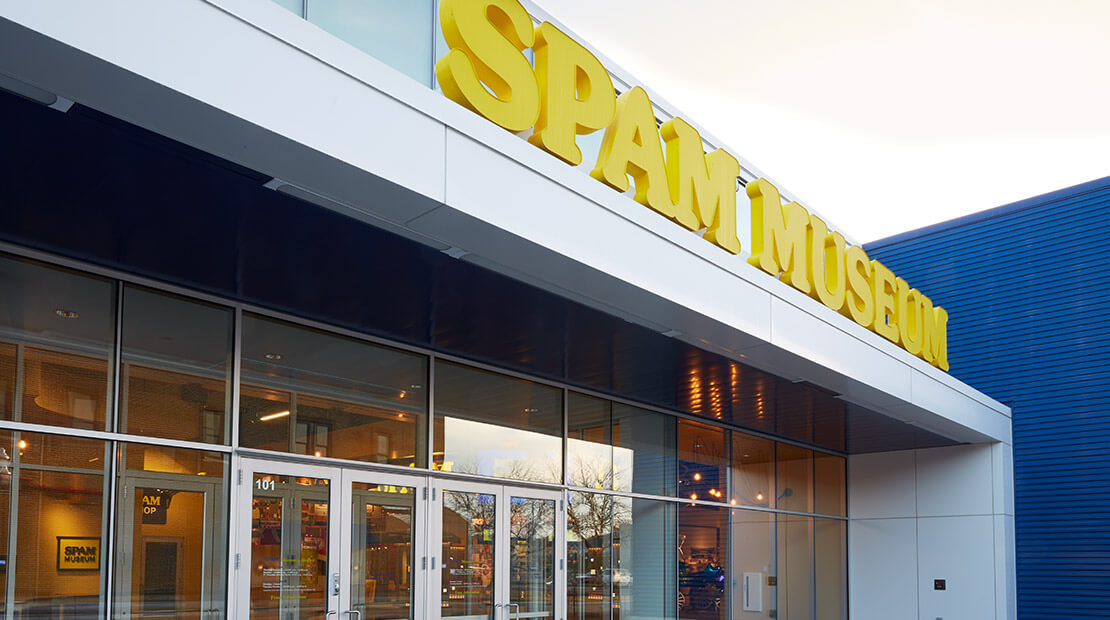Company
Midwest Traveler: SPAM Museum Makes for a Meaty Road Trip in Austin, Minn.

Star Tribune
At the Spam Museum in Austin, Minn., a smiling woman walks over with a platter of pretzel-stabbed meat cubes and earnestly asks, “Would you like a Spample?”
I try the turkey option and imagine cat food tasting somewhat similar. The Portuguese sausage variety, however, hooks me with pep and flavor that makes it popular in places such as Hawaii, where it’s food-truck fare and a breakfast staple.
Spam’s cultlike following has drawn people from 50 states and more than 70 countries to this oddity of a museum — a free shrine to the often-mocked canned meat. For fans, the place is worthy of a pilgrimage. For others, it’s a chance to enjoy the cheeky humor behind Spam, with surprising stories of war, peace and global goodwill that can come from a humble rectangular can.
The origin of Spam began with a naming contest for Hormel’s new canned lunchmeat in the 1930s. The winner couldn’t anticipate that the name would someday encompass unwanted e-mails, become a verb and inspire “Spamalot,” the Monty Python musical.
When World War II rationing restricted production of tins and sugar, 90 percent of all canned foods were sent to soldiers overseas. The Supporting Our Troops exhibits tell how 1,961 Hormel employees enlisted in the military after Pearl Harbor, and the local plant became a war facility producing K-rations. With added ingredients such as apple flakes, carrots and eggs, Spam became a ready-to-eat meal.
The company’s wartime role continued in Korea and Vietnam. That likely fed into Spam’s coveted status in Asia, where postwar Koreans would scrounge for meals using old war rations and concocting budae-jjigae (“army stew”), a mix of Spam, baked beans, kimchi, ramen and spices. South Korea consumes about $250 million worth of Spam a year.
In Japan, especially near Okinawa, cooks make champuru, a Spam stir fry. Even Britain has its own twist, making Spam fritters that are eaten with mushy peas and chips.
“Visitors are shocked at how much people around the world love Spam,” said Steve Nordrum, one of the Austin “Spambassadors” who often lead museum tours.
A British man, whose father and grandfather worked at the former Spam plant in Liverpool, had his middle name legally changed to “I Love Spam” in 2016. He then got married at the Austin museum in 2017 before a honeymoon at Hawaii’s popular Spam Jam, a festival that draws up to 30,000 people a year. Hawaii consumes more Spam than any other state. Seven-Eleven stores there sell 75,000 bars of musubi (grilled Spam atop rice and wrapped in nori) every week.
If you want to eat like Hawaiians, you may need to road-trip to the Spam museum, which carries a full array of global flavors such as Portuguese sausage, teriyaki, Tocino and chorizo. Watch for Spamples.
The free museum also features interactive exhibits, including a production line and kids’ play area, along with quirky Spam-branded souvenirs such as T-shirts and Snuggies, skateboards, air fresheners, gift wrap and “canjos” — homemade banjos made from Spam cans (1-507-437-5100; spam.com).